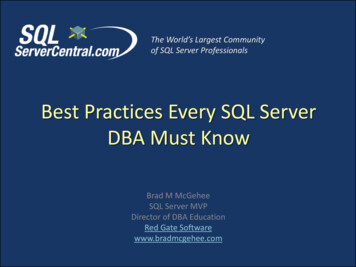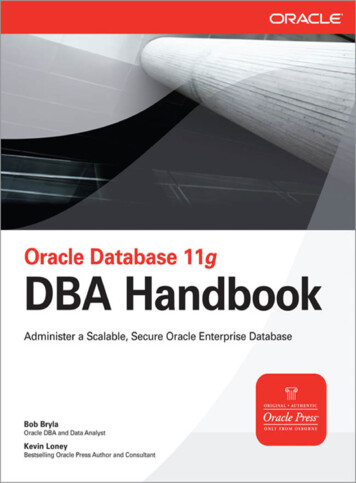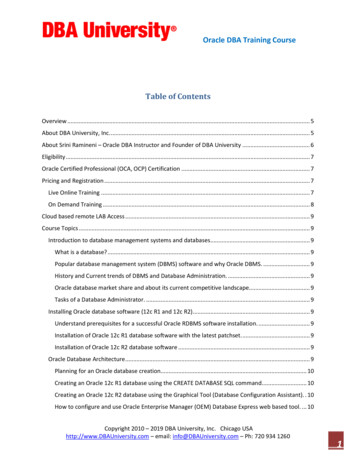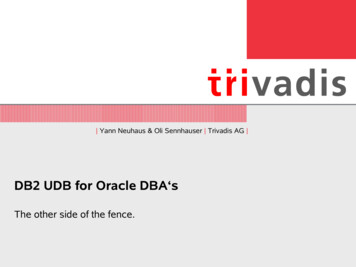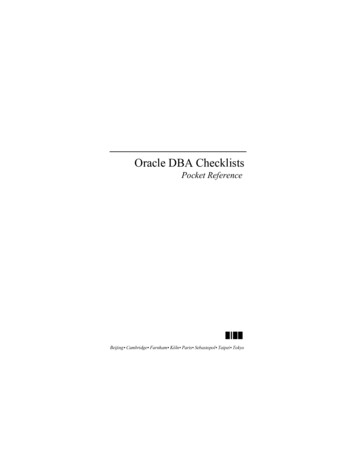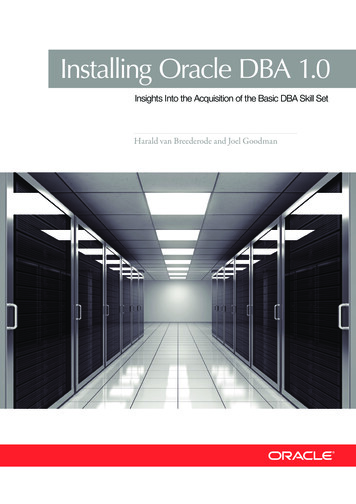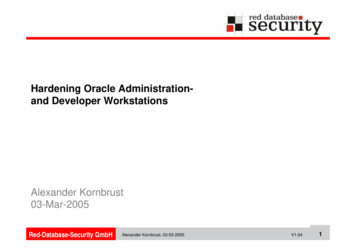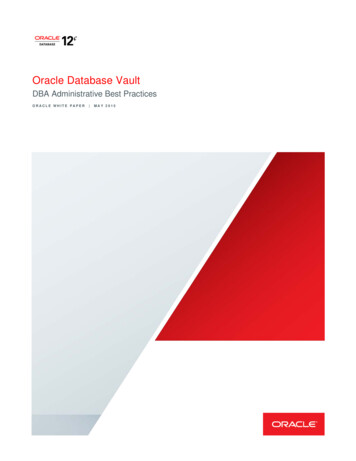
Transcription
Oracle Database VaultDBA Administrative Best PracticesORACLE WHITE PAPER MAY 2015
Table of ContentsIntroduction2Database Administration Tasks Summary3General Database Administration Tasks4Managing Database Initialization Parameters4Scheduling Database Jobs5Administering Database Users7Managing Users and Roles7Managing Users using Oracle Enterprise Manager8Creating and Modifying Database Objects8Database Backup and RecoveryOracle Data Pump89Security Best Practices for using Oracle RMAN11Flashback Table11Managing Database Storage Structures12Database Replication12Oracle Data Guard12Oracle Streams12Database Tuning12Database Patching and Upgrade14Oracle Enterprise Manager16Managing Oracle Database Vault17Conclusion201 ORACLE DATABASE VAULT DBA ADMINISTRATIVE BEST PRACTICES
IntroductionOracle Database Vault provides powerful security controls for protecting applications and sensitive data.Oracle Database Vault prevents privileged users from accessing application data, restricts ad hocdatabase changes and enforces controls over how, when and where application data can be accessed.Oracle Database Vault secures existing database environments transparently, eliminating costly and timeconsuming application changes.With the increased sophistication and number of attacks on data, it is more important than ever to putmore security controls inside the database. However, most customers have a small number of DBAs tomanage their databases and cannot afford having dedicated people to manage their database security.Database consolidation and improved operational efficiencies make it possible to have even less peopleto manage the database. Oracle Database Vault controls are flexible and provide security benefits tocustomers even when they have a single DBA. For large and medium sized IT departments, OracleDatabase Vault controls help enforce the necessary protections for outsourcing and off-shoring whereoutside DBAs can manage the database without having access to application data.Oracle Applications and major partner applications have been certified with Oracle Database Vault.Oracle Database Vault protections are available for Oracle E-Business Suite, Oracle PeopleSoft, OracleSiebel, Oracle JD Edwards EnterpriseOne, Oracle Retail, and Oracle Financial Services. OracleDatabase Vault protections are also available for SAP and Infosys Finacle. For more information on thisand on how to protect your custom applications with Oracle Database Vault, visit the Oracle DatabaseVault web page mentioned below.This paper covers DBA best practices with Oracle Database Vault. The major topics covered in thispaper are: General Database Administration Tasks, Administering Database Users, Database Backupand Recovery, Database Replication, Database Tuning, Database Patching and Upgrade, and OracleEnterprise Manager. For each of these topics, DBA best practices with Oracle Database Vault andsecurity considerations are described. This paper also covers Managing Oracle Database Vault anddetails various customers’ scenarios.After reading this paper, DBAs should understand how to manage Oracle Database with OracleDatabase Vault.This paper assumes the reader has basic knowledge of Oracle Database Vault. For an introduction onOracle Database Vault, refer to the Oracle Database Vault web page ons/database-vault/index-085211.html2 ORACLE DATABASE VAULT DBA ADMINISTRATIVE BEST PRACTICES
Database Administration Tasks SummaryThe following table lists the common database administration tasks and shows where Oracle Database Vaultoperational controls are required.Administration TaskOracle Database Vaultoperational controls required?CommentsGeneral Database Administration TasksStarting up and shutting downthe databaseNoCreating databasesNoConfiguring database networkconnectivityNoDatabase cloningNoManaging databaseinitialization parametersYesSome parameters are protected by theALTER SYSTEM command rule.Scheduling database jobsYesProper Oracle Database Vault authorizationshould be granted for this task.Managing users and rolesYesSee relevant section in this paper.Creating and modifyingdatabase objectsYesSee relevant section in this paper.Oracle Data PumpYesProper Oracle Database Vault authorizationshould be granted before doing this task.Oracle RMANNoSee relevant section in this paper onOracle RMAN security best practices.Oracle SQL*LoaderNoFlashbackYesProper Oracle Database Vault authorizationshould be granted before doing this task.Managing database storagestructuresYesRequires authorization to the OracleData Dictionary realm.Oracle Data GuardYesSupport note number 754065.1 provides stepby-step instructions on this.Oracle StreamsYesProper Oracle Database Vault authorizationshould be granted before doing this task.Administering Database UsersDatabase Backup and recoveryDatabase ReplicationDatabase TuningDBMS STATS PL/SQLPackageNoModifying database instancememoryNoAutomatic databasediagnostic monitor (ADDM)NoActive session history (ASH)NoAutomatic workload repository(AWR)No3 ORACLE DATABASE VAULT DBA ADMINISTRATIVE BEST PRACTICES
Administration TaskOracle Database Vaultoperational controls required?CommentsSQL Tuning AdvisorNoEXPLAIN PLANYesPLAN TABLE should be accessible toDBA.ANALYZE TABLEYesCHAINED ROWS table should be accessible toDBA.Maintaining indexesYesSee relevant section in this paper.Performing database patchingYesSee relevant section in this paper.Performing software upgradeNoPerforming database upgradeYesDatabase Patching and UpgradeSee relevant section in this paper.Oracle Enterprise ManagerConfiguring Oracle EnterpriseManager settingsNoAdding administrators inOracle EnterpriseManagerYesSee relevant section in this paper.Table 1 Summary of common DBA activities with comments where operational controls are requiredGeneral Database Administration TasksThis section discusses general database tasks that don’t fall under the other main topics covered in this paper. Inparticular, this section covers Managing Database Initialization Parameters and Scheduling Database Jobs andwhat Oracle Database Vault controls are required to do these tasks.Managing Database Initialization ParametersSome Database initialization parameters are controlled and protected by the ALTER SYSTEM command rule.These parameters are listed in the Oracle Database Vault Administrator’s Guide, in the Default Rule Sets section,under “Allow Fine Grained Control of System Parameters” rule set. For a DBA to be able to alter these parameters,the following requirements need to be satisfied:1. DBA user should have ALTER SYSTEM privilege.4 ORACLE DATABASE VAULT DBA ADMINISTRATIVE BEST PRACTICES
2. DBA user should be added to the rule set “Allow Fine Grained Control of System Parameters”. This is done byediting the rule set and adding a new rule that allows that. In the example shown in the screen, we add a rule wecall “Verify user is allowed on ALTER SYSTEM command”. This rule verifies that the session user isDBA JSMITH before allowing the user to change the protected initialization parameters. The rule expression weuse is: SYS CONTEXT (‘USERENV’,’SESSION USER’) ’DBA JSMITH’.Figure 1 An example of a rule added to the rule set controlling the ALTER SYSTEM Command RuleNote that customers can add their own rule or rules to allow multiple users or roles in their environment to changethe protected initialization parameters.3. Change the rule set evaluation option from “All True” to “Any True” and click OK to save the changes.Figure 2 Change the Evaluation Type to "Any True" for the rule set of the ALTER SYSTEM Command RuleNow the authorized DBA will be able to alter all database initialization parameters including the protected ones.Scheduling Database JobsScheduling a database job against a realm-protected schema requires Oracle Database Vault controls. This is toensure proper authorization is in place. A DBA can be authorized to schedule database jobs on a schema byschema basis or on the entire database. Note that the DBA still needs the appropriate system privileges to run adatabase job such as CREATE JOB, CREATE ANY JOB, and MANAGE SCHEDULER.5 ORACLE DATABASE VAULT DBA ADMINISTRATIVE BEST PRACTICES
In the following example, the DBA is authorized to schedule and run database jobs on the realm- protected HRapplication.Figure 3 DBA JSMITH is authorized to schedule database jobs on the realm-protected HR applicationThe following screen shows how to authorize the DBA to schedule jobs on the entire database:Figure 4 DBA JSMITH is authorized to schedule database jobs on the entire databaseIf the DBA no longer needs to run database jobs on the entire database or on realm-protected schemas, theauthorizations can be revoked as shown in the screens below.Figure 5 Revoking authorization from DBA JSMITH to schedule database jobs on HR applicationFigure 6 Revoking authorization from DBA JSMITH to schedule database jobs on the entire database6 ORACLE DATABASE VAULT DBA ADMINISTRATIVE BEST PRACTICES
Administering Database UsersOracle Database Vault, optionally, separates the user administration task into a different role called DatabaseAccounts Management (DV ACCTMGR). DBAs can no longer create or manage database users by default. This isto eliminate ad hoc accounts creation and to prevent audit findings.Managing Users and RolesA Database Accounts Manager is a user who has been granted the DV ACCTMGR role. The first DatabaseAccounts Manager is created during Oracle Database Vault installation. As a best practice, the customer shouldcreate additional dedicated Database Accounts Managers and grant them the DV ACCTMGR role.The Database Accounts Manager can: create new users, grant the CONNECT role, manage existing users, andcreate and manage Oracle Database profiles. Note that, for security reasons, database accounts manager is notallowed to change the password for the Oracle Database Vault administrators (security administrators). Each OracleDatabase Vault administrator can change his/her own password only.Once users are created, a dedicated senior DBA account can grant them system privileges and roles as needed. Asenior DBA is a DBA who has been granted the necessary system privileges and roles with ADMIN OPTION. OracleDatabase Vault controls require the senior DBA to be authorized as OWNER to the Oracle Data Dictionary realmbefore granting other users system privileges and roles.Database roles can be protected by Oracle Database Vault realms. Therefore the grantor, in addition to havingadmin option on these roles, needs to be authorized as OWNER to the realm that protects these roles. Note thatdefault database roles are protected by the Oracle Data Dictionary realm.Oracle Database Vault related roles can only be granted by the Oracle Database Vault administrator’s account thatwas created during Oracle Database Vault installation. Similarly, the DV ACCTMGR role can only be granted bythe Database Accounts Manager account that was created during Oracle Database Vault installation.7 ORACLE DATABASE VAULT DBA ADMINISTRATIVE BEST PRACTICES
Managing Users using Oracle Enterprise ManagerDatabase users can be managed from Oracle Enterprise Manager. This provides the database accounts managerwith a nice user interface. The database accounts manager needs to have the Oracle Database VaultDV ACCTMGR role. In addition, a senior DBA should grant the database accounts manager the SELECT ANYDICTIONARY privilege. Once this is done, the database accounts manager can login to Oracle Enterprise Manager;click on Server tab, then on the Users link. This is where the user management screen is located. Note that thedatabase accounts manager can manage database users and profiles but cannot grant system privileges.Figure 7 Screen shows database accounts manager managing database users from Oracle Enterprise ManagerCreating and Modifying Database ObjectsA database user with the proper system privileges can create and modify database objects in his/her schema.However, if the user’s schema is protected by a realm, then the user needs to be authorized as owner in the realm.This allows the user to be able to execute Data Definition Language (DDL) SQL statements such as CREATETABLE and TRUNCATE TABLE on his/her own objects. Note that Data Manipulation Language (DML) SQLstatements such as SELECT and UPDATE are not affected in this case.Oracle Database Vault Command Rules can also affect the database user’s ability to create or modify databaseobjects. For example, if needed and for added security, a command rule can be created to prevent a user fromtruncating a table he/she owns. Oracle Database Vault Command Rules can be applied to almost any of the OracleDatabase SQL commands. A set of default Command Rules are created when Oracle Database Vault is installed.They are described in the Oracle Database Vault Administrator’s Guide.Database Backup and RecoveryThis section discusses backup and recovery in an Oracle Database with Oracle Database Vault. It covers OracleData Pump and security best practices for using Oracle Recovery Manager (RMAN).8 ORACLE DATABASE VAULT DBA ADMINISTRATIVE BEST PRACTICES
Oracle Data PumpUsing Oracle Data Pump in an Oracle Database with Oracle Database Vault requires additional operational controls.This prevents ad hoc export of data while allowing authorized users to do so.For example, let us assume the HR application is protected by a realm, and a DBA needs to export a table or theentire HR application. In this case, Oracle Database Vault operational controls are required and the DBA needs tobe authorized to export the particular table or the entire HR application. The following figure shows the OracleDatabase Vault administrator (SECURITY ADMIN) authorizing DBA JSMITH to export the HR.EMPLOYEES table:Figure 8 Authorize DBA JSMITH to do Oracle Data Pump export on HR.EMPLOYEESThe DBA can be authorized to export the entire HR appli
5 ORACLE DATABASE VAULT DBA ADMINISTRATIVEBEST PRACTICES 2. DBA user should be added to the rule set “Allow Fine Grained Control of System Parameters”. This is done by editing the rule set and adding a new rule that allows that. In the example shown in the screen, we add a rule we call “Verify user is allowed on ALTER SYSTEM command”. This rule verifies that the session user is

